Imperial Dining - History of Court Dining
Dining With the Tsars
The waiters at the Imperial table were always men, selected for height, cleanliness, breeding and good looks. The waiters were looked upon as adornments to the splendidly decorated table of the Tsar. They were dressed in ceremonial livery, white tie, gloves, breeches, tall socks and shoes with non-slip soles. Waiters needed strong arms and legs as well, for they were expected to race about with heavy trays through the palace corridors. It was a prestigious position as far as Imperial servants were concerned for it involved daily service upon the person of the Tsar himself. Only the most senior of waiters could be permitted to serve the Tsar and his family and these men were attached permanently to each member of the family. They travelled with them from palace to palace and were not attached to any particular building. The Russian seniority system meant that sometimes the most august waiter was also the oldest. Nicholas suffered in silence with an old waiter he had inherited from his father. The poor man had failing eyesight and Nicholas carefully supported the faithful servant's arm while he poured the wines for want of mishap.
Waiters had the opportunity to discretly overhear gossip spoken during meals where tongues were sometimes loosened by too much wine. They became experts at listening and putting together odd snipets of conversation. They were a source of information regarding the Imperial family that couldn't be had elsewhere. Ministers were known to ask a head waiter for information on the Tsar's opinion on certain subjects.
The main course of the day was luncheon and this was the chief opportunity for formal entertaining at meals. Imperial luncheons began between 12:00 noon and 1:00 PM. According to tradition they lasted 50 minutes on the dot. The entire meal service was set on this schedule and it involved a fine choreography that was centered on the Tsar himself, who had been trained since childhood in the fine nuances of signalling the staff.
Tables for formal meals were arranged in the Semi-circular Hall or occasionally in Aleksandra's Formal Reception Room. They were arranged in two set-ups. The way they were arranged generally depended on the type of guests and the occasion. Round tables, which sat 10 to 11 people each, were ordered when the Tsar wanted more interaction or conversation with his guests. In a round table set-up the Tsar would move from one table to the next, eating different courses along the way. This enabled all of his guests to be able to say they had dined at the Tsar's table.
A long table in the shape of a squared off U was used on more formal occasions. In these setups the most senior members of the Court by position, visiting royalty according to rank , or Romanov family members according to age were placed nearest the Tsar and his wife, who stayed in one seat during the meal. This could lead to dreadfully boring conversations and it was often used to shield the Tsar from people he didn't want to talk to.
Hors d'oevres, called zakuski in Russian, were usually served in the adjoining Portrait Hall, or sometimes in the Small Library. Zakuski were either served buffet style, standing up, or served by waiters with rotating trays and were a complete meal in and of themselves. The consisted of many tasty things, including German salads, rare caviars, mushrooms and other wonderful things - all washed down with various kinds of vodkas.
While the guests enjoyed their zakuski they could see the Imperial tables set for them in the next room, glittering with silver, porcelain and crystal, crowned with candelabra and masses of fragrant flowers.
Dining tables were not permanent fixtures and were brought into the palace and set up especially for events. The gilded white Neo-classical chairs covered in yellow silk were kept in the Semi-circular Hall all the time and where arranged against the walls. When more chairs were required additional ones were brought over from the Catherine Palace. Tables were covered in splendid pure white linens woven with Imperial monograms. Guests had large matching white napkins set for them.
The heavy silver came from a variety of sources and there was lots of it. Court documents indicate the Yekaterinoslav, Moscow and Kazan silver sets were used most often. These sets had been presented by Catherine the Great to her provincial governors. Her son, Paul, thought these services were too rich for men that were his servants and had it recalled to Petersburg for use in his own palaces. The cutlery came from the Crown set or had Imperial monograms stamped on it. It was very weighty and massive. The table was also dotted with unique decorative silver pieces and vases. At each setting there were numerous little silver bowls and trays, each with a special purpose in the meal
China at the Imperial table during the time of Nicholas II usually came from the Gorbeyev set. The famous Babigon set was used only once, to celebrate the German Emperor's birthday in 1912. Twice in 1909 they used the Purple set for luncheons. As a rule matching china was used for desserts and coffee, but the blue and gilt edged Tsarskoe Selo china service was used also. Massive quantities of china were ordered from the Imperial Porcelain Factory on an annual basis and stored in the Alexander Palace basement. Pieces were marked on the bottom with the cypher of the ruling monarch and the year produced. Breakage was extensive during meals. Plus the china had to look perfect at all times for the Tsar and his guests. Damaged, cracked or imperfect china was smashed and discarded.
Magnificent crystal bowls and settings of glasses, glinted on the table. Wide-faced Tsarskoe Selo crystal decorated with enamelled Romanov Coat-of Arms was most often used for gala events. It too was ordered in large quantities.
In the early 20th century the silver candelabra used to illuminate the table were electrified. Candles and light bulbs were topped with shades of white silk.
Flowers were arranged in a special room of the palace and were an important part of the decor of the table. They were arrayed in vases and bowls while artistic sprays and individual stems of fragrant roses were strewn about. Most flowers came from the nearby Imperial Greenhouses, but others were brought in by special order. Large baskets thickly filled with rare blooms were set on the table as gifts from guests. They carried elegantly painted ribbons indicating the presentor and the occasion.
Guests were escorted by Palace servants to their appointed places at table while court musicians played in adjoining rooms. No one sat down until the Tsar had done so first.
Meals were served in three to four courses and started immediately. The Tsar did not request special foods to be served. Ever since childhood he had been taught to accept and eat was placed before him without question. His menus were selected by court officials and the chef who were generally familiar with his tastes. Aleksandra's meals were prepared and served separately. She was on a special diet established by her doctors and was usually a vegetarian. She strictly followed all of the church fasts as well.
The first course was a soup, generally a rich cream soup with small meat pies. Then followed an intermidiate course of fish. People who knew Nicholas say he loved oysters, but there is no record of them being served at meals. Perhaps they were part of the zakuski. The fish dish served most often was Dviena sterlet in champagne sauce. Next came a course of chicken in rich sauces followed by another course of either beef, mutton or ham. This course could also be game, such as pheasant, wild goat, duck or partridge.
First time guests to the Tsar's table were often confused by the service. Each course was served individually and in prepared portions, starting with the Tsar himself. The signal for having one's plate removed was placing your cutlery on the plate and removing your hands. As soon as this was done your assigned waiter would quickly remove your plate, whether you had completed eating or not. Everyone's plate was removed whenever the Tsar had finished eating which could be a problem for slow eaters and the last served. Nicholas needed to eat carefully, to insure his guests had all completed the course as well.
Before dessert came hot and cold sweet dishes, such as compotes, peaches, fresh strawberries jellies and ice creams. Then came the dessert which consisted of fresh fruits, strawberries and sometimes iced cherries.
Different sorts of wines were served at luncheons and dinners. Nicholas preferred Madeira or port with his soup. Madeira for the court came from the English firm of Krons Brothers which had supplied the court since 1888. Wines served with meat and fish dishes were more varied. White wines, such as Rudesheimer, Markobrunner, Schtrazberger and Musse came from the wine merchant Diktay on the Rhine, who supplied the court since 1884. The most preferred of the red wines were Chateau Leoville of 1881, 1887, and 1874, Chateau Lafite, Mouton Rotchilde of 1887 and Larose. As with his madeira, Nicholas never changed his affection for the French Champagne, "Monopole" from Charles Heidsieck in Rheims. Wines were served in special bottles adorned at the winery with the Imperial crest and Tsar's monogram - or in crystal carafes. The Tsar's wine cellar was exceptional and the court anticipated the rare occasions when a rare vintage was served.
After dinner coffee was served in the Portrait Hall with rich tables set with piles of chocolates, delicate sponge cakes of different sorts and shapes, and candies made in the Imperial confectionery. On separate tables there were also an assortment of liqueurs and brandies. Court brandy was usually the brandy of 1875 from Montleau and Hesse.
Although they don't appear on the menus we know from receipts that mineral waters and a wide array of soft drinks were served at table. At some point even Coca-Cola had made it into the palace, although we don't know if it was offered to guests.
As soon as the Tsar left the meal officially ended. There was no lingering about and sipping one's coffee or going back for another serving of torte before leaving. Servants immediately began to remove everything as soon as the Tsar was gone. Enormous amounts of food were prepared and there was usually lots left over. According to tradition whatever was left could be sold by the kitchen staff and the money earned was their own. Crowds sometimes gathered at the palace kitchens awaiting the potential leftovers from the Tsar's tables. The customers included members of the highest aristocracy.
Please send your comments on this page and the Time Machine to boba@pallasweb.com
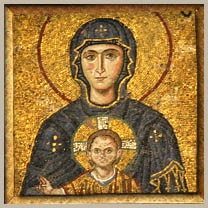
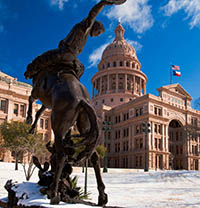



 Imperial Bedroom
Imperial Bedroom Portrait Hall
Portrait Hall Mauve Room
Mauve Room Maple Room
Maple Room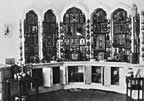 Aleksey's Bedroom
Aleksey's Bedroom Nicholas's Study
Nicholas's Study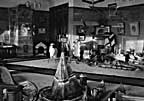 Aleksey's Playroom
Aleksey's Playroom Formal Reception
Formal Reception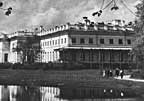 Balcony View
Balcony View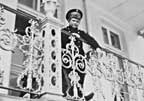 Aleksey- Balcony
Aleksey- Balcony Children-Mauve
Children-Mauve Nicholas's Bathroom
Nicholas's Bathroom Alexandra- Mauve
Alexandra- Mauve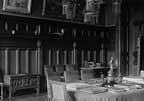 Nicholas's Reception
Nicholas's Reception Tsarskoe Selo Map
Tsarskoe Selo Map